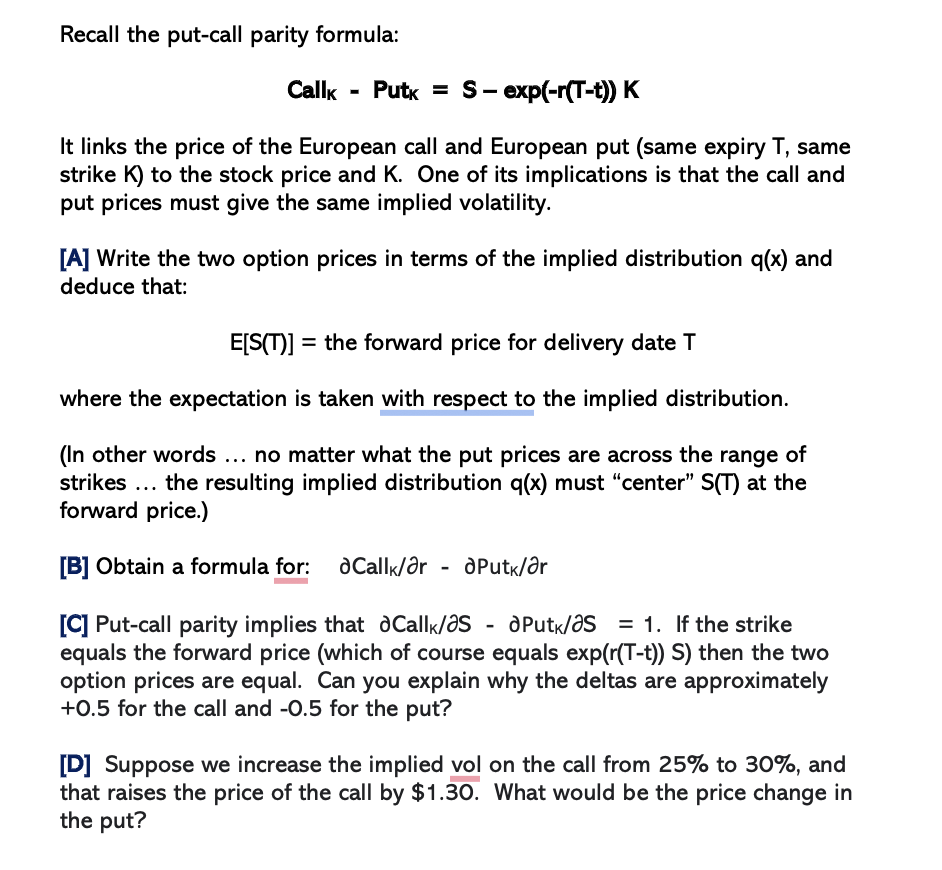Answered step by step
Verified Expert Solution
Question
1 Approved Answer
Recall the put-call parity formula: CallKPutK=Sexp(r(Tt))K It links the price of the European call and European put (same expiry T, same strike K ) to
 Recall the put-call parity formula: CallKPutK=Sexp(r(Tt))K It links the price of the European call and European put (same expiry T, same strike K ) to the stock price and K. One of its implications is that the call and put prices must give the same implied volatility. [A] Write the two option prices in terms of the implied distribution q(x) and deduce that: E[S(T)]=theforwardpricefordeliverydateT where the expectation is taken with respect to the implied distribution. (In other words ... no matter what the put prices are across the range of strikes ... the resulting implied distribution q(x) must "center" S(T) at the forward price.) [B] Obtain a formula for: CallK/rPut/r [C] Put-call parity implies that Call //SPK/S=1. If the strike equals the forward price (which of course equals exp(r(Tt))S ) then the two option prices are equal. Can you explain why the deltas are approximately +0.5 for the call and -0.5 for the put? [D] Suppose we increase the implied vol on the call from 25% to 30%, and that raises the price of the call by $1.30. What would be the price change in the put
Recall the put-call parity formula: CallKPutK=Sexp(r(Tt))K It links the price of the European call and European put (same expiry T, same strike K ) to the stock price and K. One of its implications is that the call and put prices must give the same implied volatility. [A] Write the two option prices in terms of the implied distribution q(x) and deduce that: E[S(T)]=theforwardpricefordeliverydateT where the expectation is taken with respect to the implied distribution. (In other words ... no matter what the put prices are across the range of strikes ... the resulting implied distribution q(x) must "center" S(T) at the forward price.) [B] Obtain a formula for: CallK/rPut/r [C] Put-call parity implies that Call //SPK/S=1. If the strike equals the forward price (which of course equals exp(r(Tt))S ) then the two option prices are equal. Can you explain why the deltas are approximately +0.5 for the call and -0.5 for the put? [D] Suppose we increase the implied vol on the call from 25% to 30%, and that raises the price of the call by $1.30. What would be the price change in the put Step by Step Solution
There are 3 Steps involved in it
Step: 1

Get Instant Access to Expert-Tailored Solutions
See step-by-step solutions with expert insights and AI powered tools for academic success
Step: 2

Step: 3

Ace Your Homework with AI
Get the answers you need in no time with our AI-driven, step-by-step assistance
Get Started


